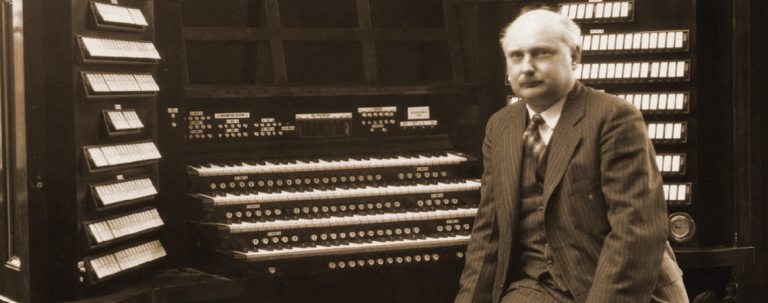Organist Firmin Swinnen gave 1,516 performances on the Longwood Gardens Aeolian Organ between 1922 and 1956. The best of his recordings have been restored and are now available on CD.
Program Notes
Firmin Swinnen (1885–1972) may be known today to only a few organ aficionados, but from 1914 until the mid 1950s he was a celebrity organist, first in Britain then in the United States. His greatest claim to fame was his 32-year association with Longwood Gardens. Swinnen was better known for his performing—and improvising—than for his published works (72 pieces for organ and/or voice). His free-wheeling style is captured on this recording.
Swinnen was born in Belgium in 1885 and graduated with the highest honors from Antwerp’s Royal Conservatory in 1906 and from the “Lemmens” School of Religious Music in 1913. World War I forced him to flee to England where he played 260 recitals to benefit Belgian relief. Swinnen and his wife then moved to the United States in 1916. That year, he began playing at the Rialto then at the Rivoli Theatre in New York City. After four years at the Rivoli, he became chief organist for the new Aldine Theatre in Philadelphia.
Meanwhile, Pierre du Pont (1870–1954) was building Longwood Gardens near Kennett Square, Pennsylvania. In 1921, an Aeolian pipe organ with 63 stops and 3,650 pipes was installed in the new Conservatory. Recitals by prominent concert organists began in 1922. Mr. du Pont’s secretary heard Swinnen play at the Aldine, and as a result Swinnen performed for the first time at Longwood on November 19, 1922. Swinnen soon became the preferred organist, giving 8 concerts in 1923 and 26 in 1924. By September 1924, he was performing every week and would do so for the next 32 years. His last contractual recital on April 29, 1956, was his 1,516th at Longwood.
The first Longwood Organ was enlarged to 79 stops in 1923, but in 1929 Mr. du Pont ordered a much larger Aeolian for Longwood’s new Ballroom. Designed by Swinnen, the four-manual instrument was custom built in Garwood, New Jersey, and cost $122,700. It has 10,010 pipes divided into 146 ranks, including five 32-foot pedal stops, and a full range of percussions. The organ was rebuilt in 1957–1959 and again in 2004–2013.
Swinnen made numerous recordings during the latter years of his career as personal keepsakes. The best of these have been restored and are presented here. One review from 1915 is just as applicable to his mature playing: “He played no music of the advanced harmonic school, neither was his treatment of the instrument at all that of the classical purist … but the greatest merit of his interpretation was in the energy of movement suggested by his actual execution of the notes—by freedom of rhythm in the grouping, hurrying, and rushing notes, overlappings which produce effects of harmonic bravura and a general impetuosity which constantly surprises the listener.” Perhaps Swinnen’s achievements are best summed up by his patron, Pierre du Pont, who wrote in 1949, “...the organ at Longwood with Firmin Swinnen at the keys touches a chord within me that responds to no other hand. May it be ever so.”
| Program | |
|---|---|
| Marche slave in B flat minor (Pyotr Ilyich Tchaikovsky ~ 1840–1893) | 7:15 |
| Clair de lune (Claude Debussy ~ 1862–1918) | 4:28 |
| Song of India (Nikolay Rimsky-Korsakov ~ 1844–1908) | 3:07 |
| Finlandia (Jean Sibelius ~ 1865–1957) | 6:51 |
| Improvisation (C minor) | 4:27 |
| Improvisation (Gong Song) | 2:47 |
| Improvisation (Chimes, Trumpets, and Vox) | 4:33 |
| Improvisation (Spanish) | 4:39 |
| Improvisation (Baghdad) | 4:33 |
| Improvisation (Wagnerian) | 4:30 |
| Improvisation (Sunset) | 4:23 |
| Fugue in d minor (Johann Sebastian Bach ~ 1685–1750) | 5:27 |
Credits
Audio Transfers: Ward Marston
Audio Restoration: Peter Krasinski
CD Materials Design: Len Levasseur
